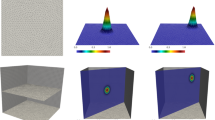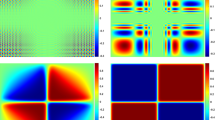Abstract
This paper considers the two-level iterative finite element methods for the steady natural convection equations under some uniqueness conditions with the Simple-, Oseen- and Newton-type corrections. Firstly, the stability and convergence of the one-level iterative finite element methods are analyzed under some restrictions on physical parameters. Secondly, under the strong uniqueness condition, we develop the two-level finite element method with Simple, Oseen and Newton iterations of m times on the coarse mesh \(\tau _H\) with mesh size H, and then, the considered problem is linearized in three correction schemes with the Simple, Oseen and Newton corrections one time on the fine grid \(\tau _h\) with mesh size \(h\ll H\) based on the obtained iterative solutions. From the theoretical point of view, the results obtained by the two-level iterative methods have the same precision as those obtained by the one-level method which mesh sizes satisfy \(h={\mathcal {O}}(H^2)\) and the iterative steps are greater than some constants. Thirdly, the stability and convergence of one-level Oseen iterative scheme with respect to the mesh size and the iterative time m are provided under a weak uniqueness condition. Finally, some numerical experiments are designed to confirm the established theoretical findings and verify the performance of the proposed numerical schemes.





Similar content being viewed by others

References
Allard F, Ghiaus C (2016) Natural ventilation in the urban environment: assessment and design. CRC Press, Taylor & Francis Group
Ball FK (1956) The theory of strong katabatic winds. Aust J Physiother 9:373–386
Bi CJ, Wang C, Lin YP (2018) Two-grid finite element method and its a posteriori error estimates for a nonmonotone quasilinear elliptic problem under minimal regularity of data. Comput Math Appl 76:98–112
Boland J, Layton W (1990) Error analysis for finite element methods for steady natural convection problems. Numer Funct Anal Optim 11:449–483
Chassignet EP, Cenedese C, Verron J (2012) Buoyancy-driven flows. Cambridge University Press, Cambridge
Chen CJ, Liu W (2015) A two-grid finite volume element method for a nonlinear parabolic problem. Int J Numer Anal Model 12:197–210
Chen CJ, Zhang XY, Zhang GD, Zhang YY (2019) A two-grid finite element method for nonlinear parabolic integro-differential equations. Int J Comput Math 96:2010–2023
Chen CJ, Liu H, Zheng XC, Wang H (2020) A two-grid MMOC finite element method for nonlinear variable-order time-fractional mobile/immobile advection–diffusion equations. Comput Math Appl 79:2771–2783
Cibik A, Kaya S (2011) A projection-based stabilized finite element method for steady-state natural convection problem. J Math Anal Appl 381:469–484
de Vahl DD (1983) Natural convection of air in a square cavity: a benchmark solution. Int J Numer Methods Fluids 3:249–264
Dong XJ, He YN, Zhang Y (2014) Convergence analysis of three finite element iterative methods for the 2D/3D stationary incompressible magnetohydrodynamics. Comput Methods Appl Mech Eng 276:287–311
Du BB, Su HY, Feng XL (2015) Two-level variational multiscale method based on the decoupling approach for the natural convection problem. Int Commun Heat Mass Transf 61:128–139
Ge L, Niu HF, Zhou JW (2022) Convergence analysis and error estimate for distributed optimal control problems governed by Stokes equations with velocity-constraint. Adv Appl Math Mech 14:33–55
Gong YJ, Chen CJ, Lou YZ, Xue GY (2021) Crank–Nicolson method of a two-grid finite volume element algorithm for nonlinear parabolic equations. East Asian J Appl Math 11(3):540–559
He YN (2015) Stability and convergence of iterative methods related to viscosities for the 2D/3D steady Navier–Stokes equations. J Math Anal Appl 423:1129–1149
He YN, Li J (2009) Convergence of three iterative methods based on the finite element discretization for the stationary Navier–Stokes equations. Comput Methods Appl Mech Eng 198:1351–1359
He YN, Wang AW (2008) A simplified two-level for the steady Navier–Stokes equations. Comput Methods Appl Mech Eng 197:1568–1576
He YN, Zhang Y, Shang YQ, Xu H (2012) Two-level Newton iterative method for the 2D/3D steady Navier–Stokes equations. Numer Methods Partial Differ Equ 28:1620–1642
Hirota R (2004) The direct method in soliton theory. Cambridge University Press, Cambridge
Hooft G (1999) Quantum gravity as a dissipative deterministic system. Class Quantum Gravity 16(10):3263
Huang PZ, Feng XL, He YN (2013) Two-level defect-correction Oseen iterative stabilized finite element methods for the stationary Navier–Stokes equations. Appl Math Model 37:728–741
Huang PZ, Li WQ, Si ZY (2015) Several iterative schemes for the stationary natural convection equations at different Rayleigh numbers. Numer Methods Partial Differ Equ 31:761–776
Jiang JT, An J, Zhou JW (2023) A novel numerical method based on a high order polynomial approximation of the fourth order Steklov equation and its eigenvalue problems. Discrete Contin Dyn Syst B 28:50–69
Jiu QS, Miao CX, Wu JH, Zhang ZF (2012) The 2D incompressible Boussinesq equations with general critical dissipation. arXiv:1212.3227
John V, Kaya S, Layton W (2006) A two-level variational multiscale method for convection-dominated convection-diffusion equations. Comput Methods Appl Mech Eng 195:4594–4603
Katsuhiro N (1995) Quantum chaos. Cambridge University Press, Cambridge
Layton W, Leferink W (1995) Two-level Picard and modified Picard methods for the Navier–Stokes equations. Appl Math Comput 69:263–274
Layton W, Meir AJ, Schmidt PG (1997) A two level discretization method for the stationary MHD equations. Electron Trans Numer Anal 6:198–210
Liu Y, Du YW, Li H, He S, Gao W (2015) Finite difference/finite element method for a nonlinear time-fractional fourth-order reactionCdiffusion problem. Comput Math Appl 70(4):573–591
Liu H, Zheng XC, Chen CJ, Wang H (2021) A characteristic finite element method for the time-fractional mobile/immobile advection diffusion model. Adv Comput Math 47:41
Luo ZD (2006) The bases and applications of mixed finite element methods. Science Press, Beijing ((in Chinese))
Luo Z, Zhu J, Xie Z, Zhang G (2003) A difference scheme and numerical simulation based on mixed finite element method for natural convection problem. Appl Math Mech (English Edition) 24:973–983
Manzari MT (1999) An explicit finite element algorithm for convective heat transfer problems. Int J Numer Methods Heat Fluid Flow 9:860–877
Massarotti N, Nithiarasu P, Zienkiewicz OC (1998) Characteristic-based-split (CBS) algorithm for incompressible flow problems with hear transfer. Int J Numer Methods Heat Fluid Flow 8:969–990
Niu HF, Yang DP, Zhou JW (2018) Numerical analysis of an optimal control problem governed by the stationary Navier–Stokes equations with global velocity-constrained. Commun Comput Phys 24:1477–1502
Qiu WL, Xu D, Guo J, Zhou J (2020) A time two-grid algorithm based on finite difference method for the two-dimensional nonlinear time-fractional mobile/immobile transport model. Numer Algorithms 85(1):39–58
Sermane M, Temam R (1983) Some mathematical questions related to the MHD equations. Commun Pure Appl Math 36:635–664
Si ZY, Shang YQ, Zhang T (2011) New one- and two-level Newton iterative mixed finite element methods for stationary conduction–convection problems. Finite Elem Anal Des 47:175–183
Si ZY, He YN, Wang K (2011) A defect-correction method for unsteady conduction–convection problems I: spatial discretization. Sci China Math 54:185–204
Si ZY, He YN, Zhang T (2012) A defect-correction method for unsteady conduction–convection problems II: time discretization. J Comput Appl Math 236:2553–2573
Su HY, Zhao JP, Gui DW, Feng XL (2014) Two-level defect-correction Oseen iterative stabilized finite element method for the stationary conduction–convection equations. Int Commun Heat Mass Transf 56:133–145
Tao ZZ, Zhang T (2015) Stability and convergence of two-level iterative methods for the stationary incompressible magnetohydrodynamics with different Reynolds numbers. J Math Anal Appl 428:627–652
Temam R (1984) Navier–Stokes equations, theory and numerical analysis, 3rd edn. North-Holland, Amsterdam
Touma JS, William MC, Thistle H, Zapert JG (1995) Performance evaluation of dense gas dispersion models. J Appl Meteorol Climatol 34:603–615
Wan DC, Patnaik BSV, Wei GW (2001) A new benchmark quality solution for the buoyancy driven cavity by discrete singular convolution. Numer Heat Transf Part B 40:199–228
Wang L, Li J, Huang PZ (2018) An efficient iterative algorithm for the natural convection equations based on finite element method. Int J Numer Methods Heat Fluid Flow 28:584–605
Wu JH (2012) The 2D incompressible Boussinesq equations. Peking University Summer School Lecture Notes, Beijing, July 23-August 3
Xu JC (1994) A novel two-grid method for semi-linear elliptic equations. SIAM J Sci Comput 15:231–237
Xu JC (1996) Two-grid discretization techniques for linear and nonlinear PDEs. SIAM J Numer Anal 33:1759–1777
Yang JT, Zhang T (2020) Stability and convergence of iterative finite element methods for the thermally coupled incompressible MHD flow. Int J Numer Methods Heat Fluid Flow 30:5103–5141
Yang JJ, He YN, Zhang GD (2018) On an efficient second order backward difference Newton scheme for MHD system. J Math Anal Appl 458:676–714
Zhang GD, He YN, Yang D (2014) Analysis of coupling iterations based on the finite element method for stationary magnetohydrodynamics on a general domain. Comput Math Appl 68:770–788
Zhang YZ, Hou YR, Zheng HB (2014) A finite element variational multiscale method for steady-state natural convection problem based on two local Gauss integrations. Numer Methods Partial Differ Equ 30:361–375
Zhang T, Zhao X, Huang PZ (2015) Decoupled two level finite element methods for the steady natural convection problem. Numer Algorithms 68:837–866
Zhang T, Feng XL, Yuan JY (2016) Implicit–explicit schemes of finite element method for the non-stationary thermal convection problems with temperature-dependent coefficients. Int Commun Heat Mass Transf 76:325–336
Zhang GD, Yang JJ, Bi CJ (2018) Second order unconditionally convergent and energy stable linearized scheme for MHD equations. Adv Comput Math 44:505–540
Zhou JW, Jiang ZW, Xie HT, Niu HF (2020) The error estimates of spectral methods for 1-dimension singularly perturbed problem. Appl Math Lett 100:106001
Zhou JW, Li HY, Zhang ZZ (2022) A posteriori error estimates of spectral approximations for second order partial differential equations in spherical geometries. J Sci Comput 90:56. https://doi.org/10.1007/s10915-021-01696-5
Author information
Authors and Affiliations
Corresponding author
Additional information
Communicated by Frederic Valentin.
Publisher's Note
Springer Nature remains neutral with regard to jurisdictional claims in published maps and institutional affiliations.
This work was supported by National Natural Science Foundation of China (nos. 11971152, 12271468), Shandong Province Natural Science Foundation (nos. ZR2021ZD03, ZR2021MA010 ) and the Natural Science Foundation of Henan Province (no. 202300410167)
Rights and permissions
Springer Nature or its licensor (e.g. a society or other partner) holds exclusive rights to this article under a publishing agreement with the author(s) or other rightsholder(s); author self-archiving of the accepted manuscript version of this article is solely governed by the terms of such publishing agreement and applicable law.
About this article
Cite this article
Zhang, H., Chen, C. & Zhang, T. Two-level iterative finite element methods for the stationary natural convection equations with different viscosities based on three corrections. Comp. Appl. Math. 42, 11 (2023). https://doi.org/10.1007/s40314-022-02147-z
Received:
Revised:
Accepted:
Published:
DOI: https://doi.org/10.1007/s40314-022-02147-z



